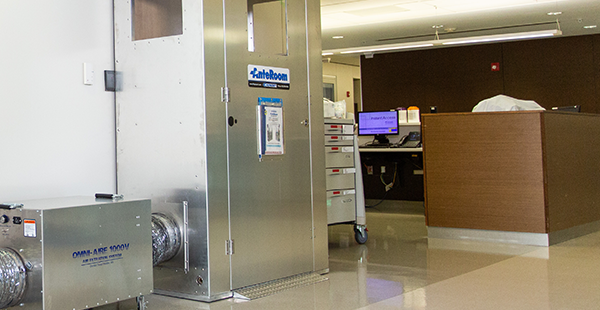
Being subjected to unclean air is hazardous for everyone. However, being exposed to unclean air is even more hazardous for the vulnerable populations in a hospital facility. When you’re managing a healthcare facility, it is important to keep your patients safe, especially when your hospital facility is undergoing renovations. Dust and other particles can be dangerous, so ensuring that the air quality is not compromised, when a renovation is being performed, is a necessary precaution. Anterooms and buffer rooms can help keep the air quality safe during renovations, but what is the difference, and which is better for your situation? Read on to find out.
What is an Anteroom?
An anteroom is a space that exists between a primary room and a working corridor, and the anteroom ensures that there will be safe airflow, in the rooms that house vulnerable populations. Usually, an anteroom and the main room are separated by a door, and there will be labels that articulate whether one space is safe or not.
Because the working space has bad air, the anteroom will have reduced airflow and heat, to keep the bad air from the working space away from the hospital’s good air. One perk of an anteroom is that it allows hospitals to perform different kinds of renovations, without having to shut down the entire building, because if there is an anteroom, people can walk into the anteroom to detox themselves, before they enter back into the main hospital space.

What is a Buffer Room?
A buffer room is a safe space that houses the engineering control area. So, inside a buffer room, a variety of things will occur, like preparing sterile supplies and staging different components for the hospital. The buffer room exists as a sterile area that stands between clean rooms and not clean rooms so that there will be less cross-contamination between the two spaces.
What is the Difference between a Buffer Room and an Anteroom?
Whereas a buffer room must ensure that there is a certain amount of cleanliness in the air, an anteroom is not necessarily a space with clear airflow. The point of an anteroom is to act as a neutral area that diminishes bad airflow in safe rooms, and the anteroom is sort of like a transition space, so there might be bad airflow in it. However, on the other hand, the buffer room is meant to be safer, because sensitive activities will be done in that room, so there must be good airflow in the buffer room.
Conclusions About Anterooms and Buffer Rooms
It is vital that you understand the difference between anterooms and buffer rooms, if you’re trying to perform renovations on your hospital facility, because understanding the distinction is important for your patients’ health. HEPACART® is committed to helping you keep your hospital facility as safe as possible. That means, that if you have any further questions about anterooms and buffer rooms, let us know. HEPACART is here to help you create the safest healthcare facility possible, even amid renovations.
Are you looking for more ways to keep your medical facility safe and protected? Download our free resource — INFECTION CONTROL FOR FACILITIES MANAGERS: THE COMPLETE GUIDE — to learn more about maintaining a facility that prioritizes the health and safety of both patients and staff.
